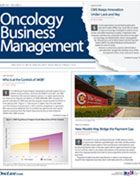Publication
Article
Special Issues
It Takes a Village, Not a Navigator
Author(s):
Pontchartrain Cancer Center was faced with the same dilemma most community-based independents have dealt with: reinvent the practice or join a hospital.
Kathy W. Oubre, MS
Our practice, Pontchartrain Cancer Center (PCC), is part of a dwindling breed. We are a community-based, two-location, private clinic in southeast Louisiana. We have been able to weather the storms of sequestration, declining reimbursements, and increased regulatory requirements. Our team takes pride in delivering personalized care to each of our patients in a warm, home-like setting. Several years ago, we were faced with the same dilemma most community-based independents have dealt with: reinvent the practice or join a hospital.
We decided to reinvent, but we didn’t have a clear vision of what sort of a practice we would have to become. How would we compete with services the hospitals and large cancer centers offer that we, as a private practice, did not get reimbursed for? What new services would strengthen our bottom line and help offset the cost of some of the new programs that would be most beneficial to our patients? How would we deal with the other programs that we simply could not afford? The PCC team met and brainstormed on our situation. An immediate decision was made to start a clinical trials program and an in-house pharmacy. The addition of these two revenue-generating initiatives, along with the new staff required to run them, allowed us the breathing room to implement other nonrevenue-generating programs felt to have tremendous value to patients and their families.
We then tackled the ancillary programs: survivorship care, nutrition, financial counseling, and patient navigation. We had always felt that a crosstrained team is the best team. Rather than hire more staff for these nonreimbursable services, we made the decision to share the additional workload among existing employees. Survivorship and nutrition are now part of the nursing and physician extender workflow, and financial counseling responsibilities are shared by the medical assistants and pharmacy technicians.
In researching the roles of patient navigators, we encountered two areas of concern: first, how many patients can one navigator actually help? Second, most of the research we could find showed only modest benefit to the patient. Consequently, we decided to let families handle the job of patient navigation—with support from the existing PCC staff. As anyone with a serious illness has experienced, the emotional impact of receiving bad news decreases our ability to receive new information. When we thought about how we could bridge this situation and best serve the patient, we decided the role of patient navigator was best played by a family member or close friend, serving as a second set of ears to help patients recall what was said during the visit. We encouraged patients to bring a family member or close friend to all visits.
During a new patient visit, family and friends are now given a simple three-ring binder with a monthly calendar in front, followed by tabs that we customize for the patient (labs, radiology results, bills, etc). They also receive a contact list with phone numbers and names for the departments within our practice. At the subsequent chemo education visit, we further customize the binder with a list of the patient’s team of doctors and support staff and more contact information. We go over regimens, medications, side effects, and any other written materials that are necessary. We update the binder at every visit to include follow-up appointments with us and other appointments we have made for the patient (labs, radiology, other physicians, etc). We encourage patients to bring this working document to appointments with everyone on their care team and to have those healthcare workers add to it, also.
We realize that this may not be enough, given that the average person’s health literacy is lower than optimal. It may be necessary to take the extra time and set up another appointment or provide additional or different written materials—and that is OK. Patients with cancer often come to us when they are most vulnerable, and the team felt it imperative to invoke the adage “treat others as you would want to be treated.” This team approach to our new programs paid dividends. It allowed us to control the message and the expense of care. Although we have all taken on more work to meet these needs, patient and PCC staff satisfaction has gone up due to the strengthening of the patient/family relationship with virtually every member of the PCC staff.

Latest Conference Coverage

Dr Meric-Bernstam on the Efficacy and Safety of Dato-DXd in Metastatic Urothelial Cancer
%20u.jpg?fit=crop&auto=format)
Orca-Q Shows Promise in High-Risk Hematologic Cancers and BFT Conditioning May Synergize With the Agent

Avelumab Maintenance Improves OS and PFS in Advanced Urothelial Carcinoma, Regardless of Diabetes Status

Obe-Cel Elicits High MRD-Negative Response Rates in R/R B-ALL
2 Commerce Drive
Cranbury, NJ 08512




